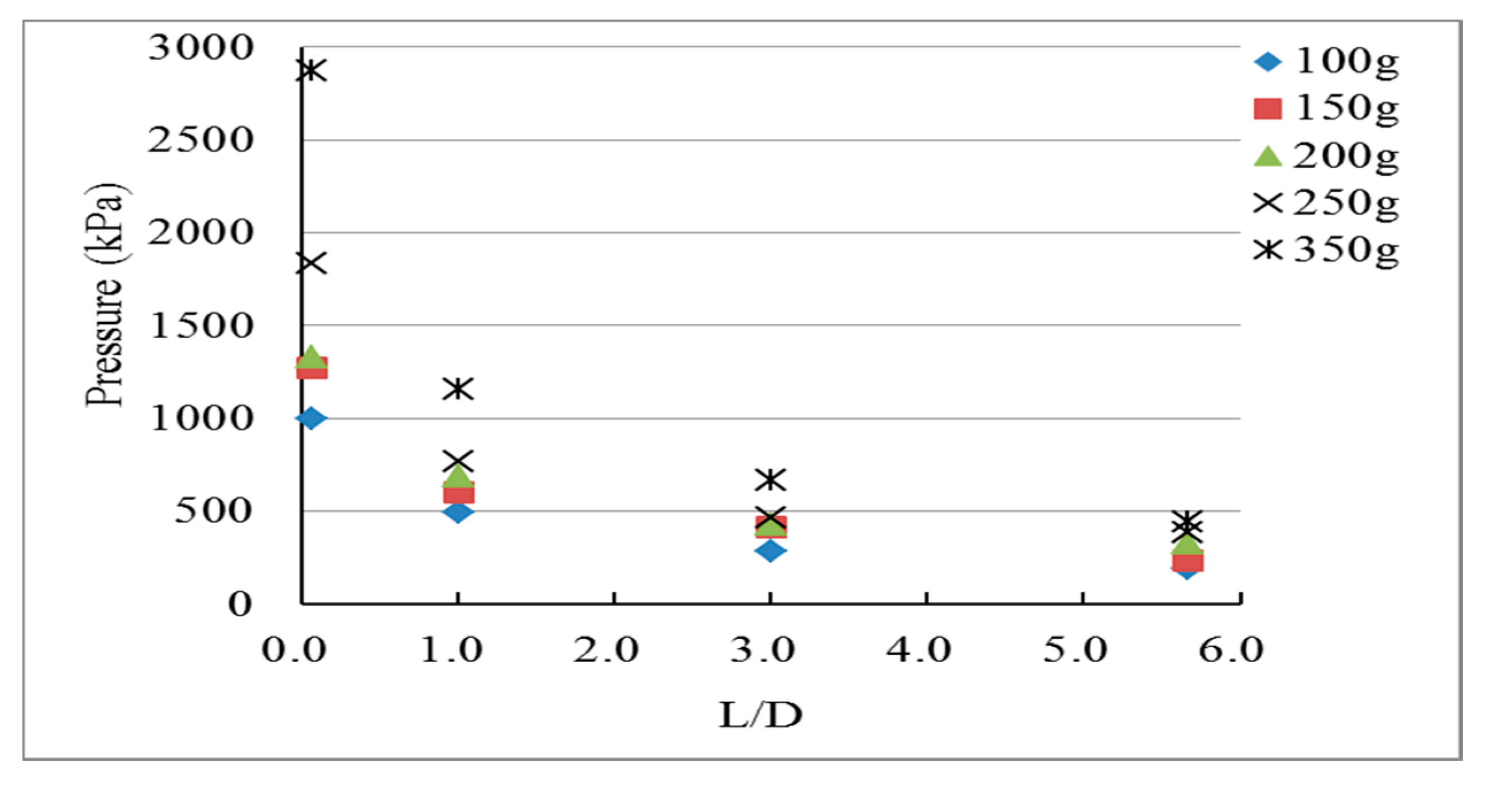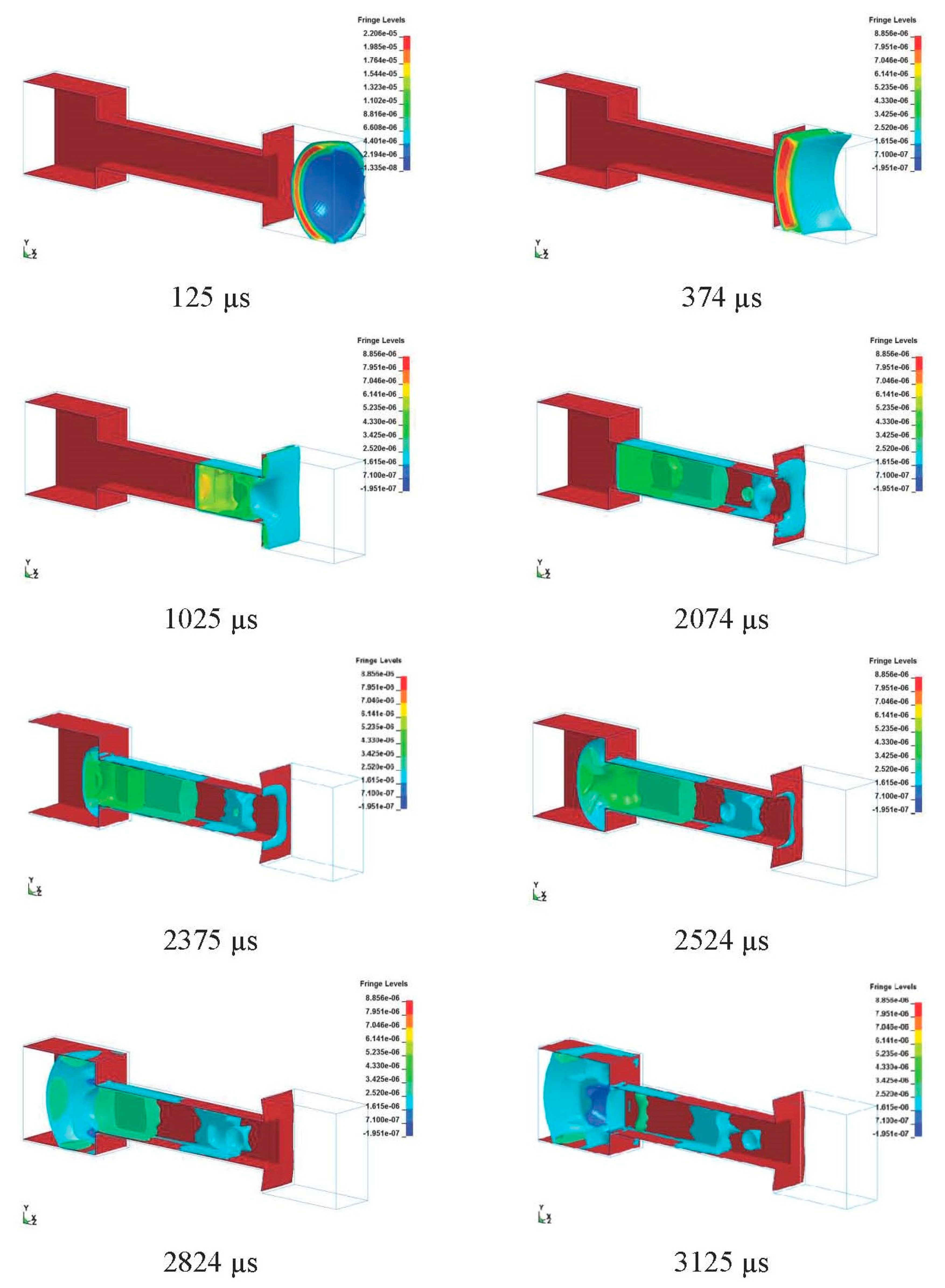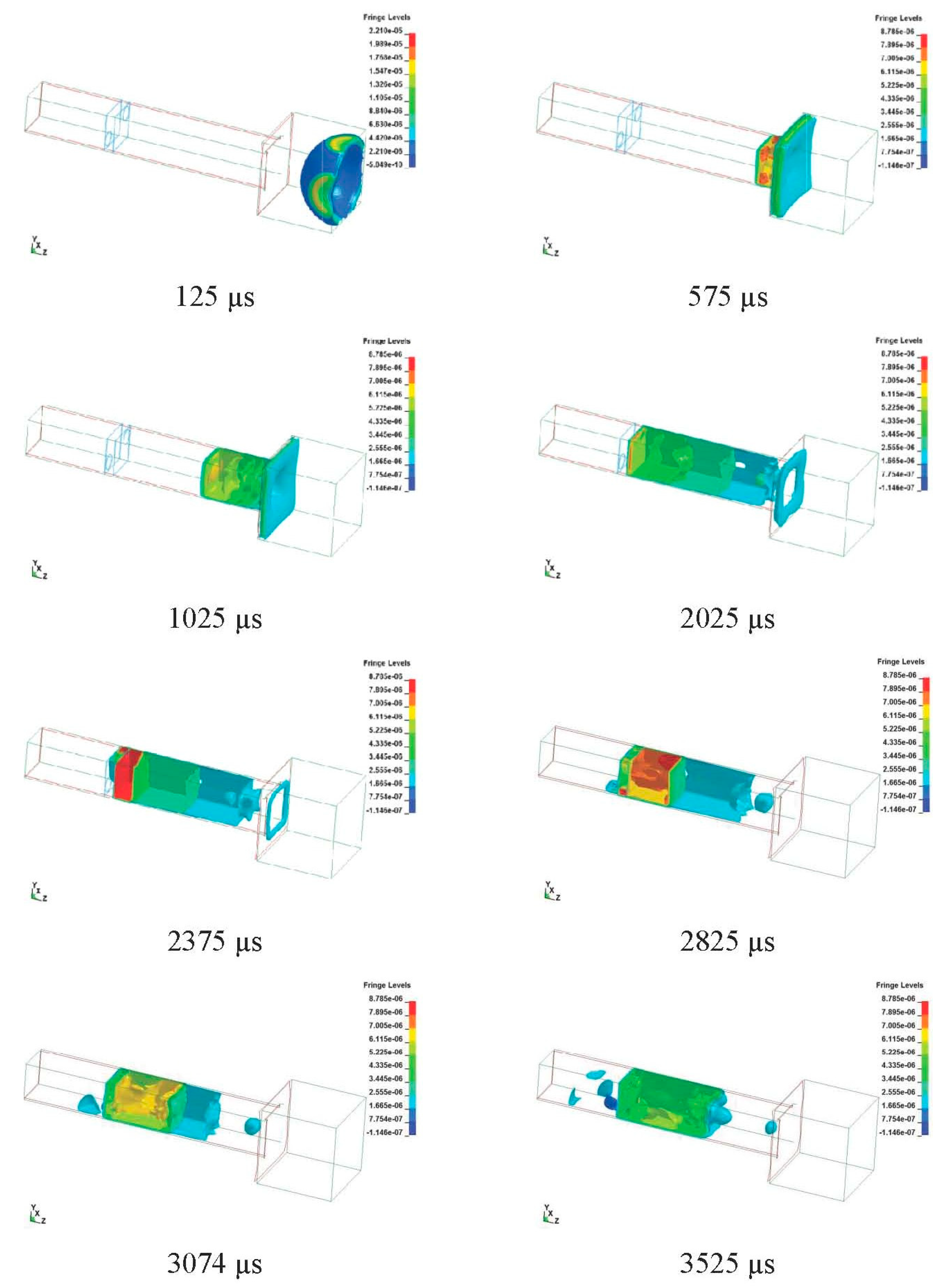Numerical Study of Pressure Attenuation Effect on Tunnel Structures Subjected to Blast Loads
Abstract
1. Introduction
2. Experiment
2.1. Explosion Experiment on the Pressure Reduction Module Effect
2.1.1. Linear Tunnel with Expansion Chamber
2.1.2. Linear Tunnel with One-Pressure Relief Orifice Plate
2.1.3. Linear Tunnel with Double-Pressure Relief Orifice Plate
3. Numerical Simulation
3.1. Numerical Models
3.2. Constitutive Models and Equation of State
3.2.1. Air
3.2.2. Explosive
3.2.3. Steel Plate
4. Results
4.1. Pressure Reduction Module Effect Analysis
4.1.1. Linear Tunnel with Expansion Chamber Explosion
4.1.2. Linear Tunnel with Single-Pressure Relief Orifice Plate Explosion
4.1.3. Linear Tunnel with Double-Pressure Relief Orifice Plate Explosion
5. Conclusions
- (1)
- The pressure reduction module (expansion chamber, one-pressure relief orifice plate, double-pressure relief orifice plate) changes the tunnel section to diffuse the blast and reduce or detour the transfer; thus, the aforesaid design modes have a blast attenuation effect.
- (2)
- The pressure reduction modules are designed inside the tunnel, and the findings show that the double-pressure relief orifice plate has better blast attenuation effect than the one-pressure relief orifice plate, and the one-pressure relief orifice plate is better than the expansion chamber. The expansion chamber can attenuate the blast by 30%. The one-pressure relief orifice plate can attenuate the blast by 51%. The double-pressure relief orifice plate can attenuate the blast by 82%.
- (3)
- The overall blast attenuation trend in the numerical simulation result of the pressure reduction module matches the experimental result. The results of this study can provide a reference for future protective designs.
Author Contributions
Funding
Institutional Review Board Statement
Informed Consent Statement
Acknowledgments
Conflicts of Interest
References
- Smith, P.D.; Vismeg, P.; Teo, L.C.; Tingey, L. Blast wave transmission along rough-walled tunnels. Int. J. Impact Eng. 1998, 24, 419–432. [Google Scholar] [CrossRef]
- Yu, W.F.; Hung, C.W.; Cheng, D.S. E_ect of Subdividing Stacks on Blast Overpressure from Explosion inside Ammunition Storage Magazine. J. Explos. Propellants 2008, 24, 25–40. [Google Scholar]
- Luccioni, B.; Ambrosini, D.; Nurick, G.; Snyman, I. Craters produced by underground explosions. Comput. Struct. 2009, 87, 1366–1373. [Google Scholar] [CrossRef]
- Yu, W.F.; Hung, C.W.; Cheng, D.S. Effect of Blast wall on Safety Distance of Ammunition Storage Magazine Subjected to Internal Explosion. J. Chung Cheng Inst. Technol. 2010, 39, 131–145. [Google Scholar]
- Cheng, D.S.; Hung, C.W. Experiment and Numerical Simulation of Peak Overpressure of C4 Explosives in the Airblast. J. Explos. Propellants 2010, 26, 75–96. [Google Scholar]
- Pi, S.J.; Cheng, D.S.; Cheng, H.L.; Li, W.C.; Hung, C.W. Fluid-Structure- Interaction for a Steel Plate subjected to Non-Contact Explosion. Theor. Appl. Fract. Mech. 2012, 59, 1–7. [Google Scholar] [CrossRef]
- Zakrisson, B.; Wikman, B.; Häggblad, H.Å. Numerical simulations of blast loads and structural deformation from near-field explosions in air. Int. J. Impact Eng. 2011, 38, 597–612. [Google Scholar] [CrossRef]
- Hung, C.W.; Tsai, Y.K.; Chen, T.A.; Wu, P.W. An experimentally validated numerical model for the near-field explosion of an ammunition storage magazine. Appl. Sci. 2020, 19, 6849. [Google Scholar] [CrossRef]
- Hung, C.W.; Lai, H.H.; Shen, B.C.; Wu, P.W.; Chen, T.A. Development and Validation of Overpressure Response Model in Steel Tunnels Subjected to External Explosion. Appl. Sci. 2020, 18, 6166. [Google Scholar] [CrossRef]
- Lai, H.H. Applicability of a Design Assessment and Management for the Current Ammunition Depots in Taiwan. Appl. Sci. 2020, 10, 1041. [Google Scholar] [CrossRef]
- Son, S.Y.; Lee, J.; Ahn, W.; Kim, H.W.; Choi, J.S. Effect of Blast Traps on Air-blast Propagation in Underground Storage. In Proceedings of the 25th Explosives Safety Seminar, 25th DoD Explosives Safety Seminar, Anaheim, CL, USA, 8 August 1992; pp. 85–98. [Google Scholar]
- Scheklinski-Gluck, G. Blast in Tunnels and Rooms from Cylindrical HE-Charges Outside the Tunnel Entrance. In Proceedings of the Sixth International Symposium on Interaction of Nonnuclear Munitions with Structures, Panama City, FL, USA, 3–7 May 1993; pp. 68–73. [Google Scholar]
- McMahon, G.W.; Britt, J.R.; Patterson, B.C. Airblast Propagation within Tunnels from Portal Detonations; MABS 18: Bad Reichenhall, Germany, 2004; Available online: https://www.mabs.ch/spiez-base/mabs-16-to-20/mabs-18/ (accessed on 17 June 2021).
- Technical Manual TM5-855-1. Fundamental of Protective Design for Conventional Weapons; Department of the Army: Washington DC, USA, 1998. Available online: https://www.nrc.gov/docs/ML1019/ML101970069.pdf (accessed on 17 June 2021).
- Welch, B.; McMahon, G.W.; Davis, K. Transportation Tunnels and Terrorist Attacks; ERDC: Vicksburg, MS, USA, 2005. [Google Scholar]
- Cheng, D.S.; Chang, Y.L.; Yu, W.F.; Yen, C.P.; Lee, K.H.; Wu, K.H. Simulation of explosions inside ammunition storage magazines of strip and bent channels. In Proceedings of the 16th Seminar on National Defence Science and Technology, Taoyuan, Taiwan, 2008; pp. 1–6. [Google Scholar]
- Ishikawa, N.; Beppu, M. Lessons from past explosive tests on protective structures in Japan. Int. J. Impact Eng. 2007, 34, 1535–1545. [Google Scholar] [CrossRef]










| Weight of C-4 (g) | 100 | 150 | 200 | 250 | 350 | |||
|---|---|---|---|---|---|---|---|---|
| Position | P1 (L/D = 0.07) | Experiment | Explosion pressure (kPa) | 999.27 | 1276.14 | 1327.74 | 1834.18 | 2873.28 |
| Simulation | 889.32 | 1207.76 | 1553.81 | 1725.41 | 2281.28 | |||
| P2 (L/D = 1.00) | Experiment | Explosion pressure (kPa) | 492.06 | 600.50 | 593.31 | 766.60 | 1158.69 | |
| Simulation | 591.04 | 747.45 | 872.07 | 967.59 | 1133.06 | |||
| P3 (L/D = 3.00) | Experiment | Explosion pressure (kPa) | 282.81 | 417.29 | 427.71 | 468.46 | 664.85 | |
| Simulation | 449.52 | 554.88 | 639.48 | 700.86 | 816.89 | |||
| P4 (L/D = 5.67) | Experiment | Explosion pressure (kPa) | 189.52 | 237.99 | 332.31 | 384.24 | 443.45 | |
| Blast transfer rate () | 0.67 | 0.57 | 0.78 | 0.82 | 0.67 | |||
| Average: 0.7 | ||||||||
| Simulation | Explosion pressure (kPa) | 244.00 | 304.74 | 354.77 | 391.55 | 462.05 | ||
| Blast transfer rate () | 0.54 | 0.55 | 0.55 | 0.56 | 0.57 | |||
| Average: 0.55 | ||||||||
| Weight of C-4 (g) | 100 | 150 | 200 | 250 | 350 | |||
|---|---|---|---|---|---|---|---|---|
| Position | P1 (L/D = 0.07) | Experiment | Explosion pressure (kPa) | 784.67 | 1164.00 | 1777.00 | 1763.02 | 2443.99 |
| Simulation | 792.96 | 1006.73 | 1623.96 | 1721.41 | 2175.51 | |||
| P2 (L/D = 1.00) | Experiment | Explosion pressure (kPa) | 457.43 | 642.93 | 760.66 | 908.14 | 1502.18 | |
| Simulation | 584.15 | 739.17 | 863.49 | 960.17 | 1126.15 | |||
| P3 (L/D = 3.00) | Experiment | Explosion pressure (kPa) | 300.49 | 367.77 | 454.65 | 482.50 | 747.77 | |
| Simulation | 568.95 | 617.27 | 655.25 | 702.23 | 837.73 | |||
| P4 (L/D = 5.67) | Experiment | Explosion pressure (kPa) | 123.89 | 170.62 | 242.00 | 272.76 | 348.09 | |
| Blast transfer rate () | 0.41 | 0.46 | 0.53 | 0.57 | 0.47 | |||
| Average: 0.49 | ||||||||
| Simulation | Explosion pressure (kPa) | 117.91 | 144.36 | 166.38 | 182.05 | 211.96 | ||
| Blast transfer rate () | 0.21 | 0.23 | 0.25 | 0.26 | 0.25 | |||
| Average: 0.24 | ||||||||
| Weight of C-4 (g) | 100 | 150 | 200 | 250 | 350 | |||
|---|---|---|---|---|---|---|---|---|
| Position | P1 (L/D = 0.07) | Experiment | Explosion pressure (kPa) | 711.49 | 779.04 | 1568.8 | 1950.37 | 2294.61 |
| Simulation | 792.96 | 1006.73 | 1523.11 | 1786.34 | 2204.64 | |||
| P2 (L/D = 1.00) | Experiment | Explosion pressure (kPa) | 379.33 | 454.14 | 686.29 | 782.28 | 986.88 | |
| Simulation | 584.15 | 739.17 | 863.49 | 960.17 | 1126.15 | |||
| P3 (L/D = 3.00) | Experiment | Explosion pressure (kPa) | 272.79 | 306.57 | 450.01 | 544.88 | 703.04 | |
| Simulation | 651.38 | 780.52 | 739.47 | 787.03 | 843.57 | |||
| P4 (L/D = 5.67) | Experiment | Explosion pressure (kPa) | 38.18 | 52.33 | 71.64 | 108.96 | 166.3 | |
| Blast transfer rate () | 0.14 | 0.17 | 0.16 | 0.20 | 0.24 | |||
| Average: 0.18 | ||||||||
| Simulation | Explosion pressure (kPa) | 65.40 | 101.19 | 116.50 | 128.89 | 151.12 | ||
| Blast transfer rate () | 0.10 | 0.13 | 0.16 | 0.16 | 0.18 | |||
| Average: 0.15 | ||||||||
| Weight of C-4 | 100 g | 150 g | 200 g | 250 g | 350 g | |
|---|---|---|---|---|---|---|
| Expansion chamber | P1 | 11% | 5.4% | 17% | 5.9% | 20.6% |
| P2 | 20% | 24% | 46% | 26.2% | 2.21% | |
| P3 | 59% | 33% | 49% | 49.6% | 22.8% | |
| P4 | 29% | 28% | 6.8% | 1.9% | 4.2% | |
| Single-orifice plate | P1 | 1% | 13.5% | 8.6% | 2.3% | 10.9% |
| P2 | 27.7% | 14.9% | 13.5% | 5.7% | 25% | |
| P3 | 89.3% | 67.9% | 44.1% | 45.5% | 12% | |
| P4 | 4.8% | 15.4% | 31.2% | 33.3% | 39.1% | |
| Double-orifice plate | P1 | 11.4% | 29.3% | 2.9% | 8.4% | 3.9% |
| P2 | 53.9% | 62.7% | 25.8% | 22.7% | 14.1% | |
| P3 | 138% | 154% | 64.3% | 44.4% | 19% | |
| P4 | 71.2% | 93.3% | 62.6% | 18.3% | 9.12% |
Publisher’s Note: MDPI stays neutral with regard to jurisdictional claims in published maps and institutional affiliations. |
© 2021 by the authors. Licensee MDPI, Basel, Switzerland. This article is an open access article distributed under the terms and conditions of the Creative Commons Attribution (CC BY) license (https://creativecommons.org/licenses/by/4.0/).
Share and Cite
Hung, C.-W.; Tsai, Y.-K.; Chen, T.-A.; Lai, H.-H.; Wu, P.-W. Numerical Study of Pressure Attenuation Effect on Tunnel Structures Subjected to Blast Loads. Appl. Sci. 2021, 11, 5646. https://doi.org/10.3390/app11125646
Hung C-W, Tsai Y-K, Chen T-A, Lai H-H, Wu P-W. Numerical Study of Pressure Attenuation Effect on Tunnel Structures Subjected to Blast Loads. Applied Sciences. 2021; 11(12):5646. https://doi.org/10.3390/app11125646
Chicago/Turabian StyleHung, Cheng-Wei, Ying-Kuan Tsai, Tai-An Chen, Hsin-Hung Lai, and Pin-Wen Wu. 2021. "Numerical Study of Pressure Attenuation Effect on Tunnel Structures Subjected to Blast Loads" Applied Sciences 11, no. 12: 5646. https://doi.org/10.3390/app11125646
APA StyleHung, C.-W., Tsai, Y.-K., Chen, T.-A., Lai, H.-H., & Wu, P.-W. (2021). Numerical Study of Pressure Attenuation Effect on Tunnel Structures Subjected to Blast Loads. Applied Sciences, 11(12), 5646. https://doi.org/10.3390/app11125646






